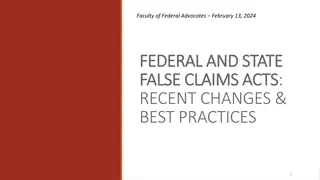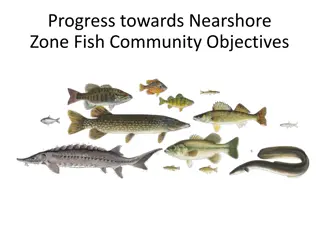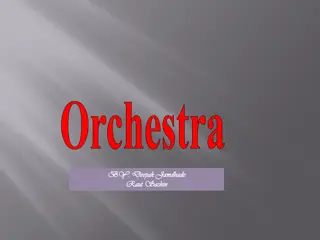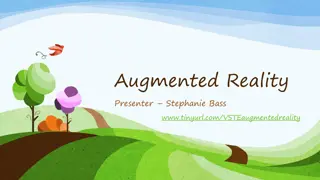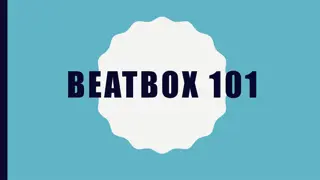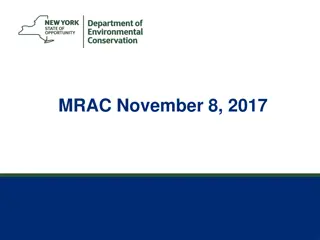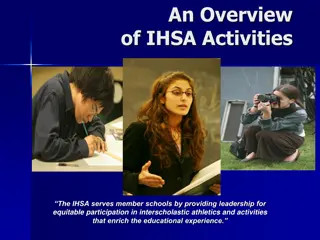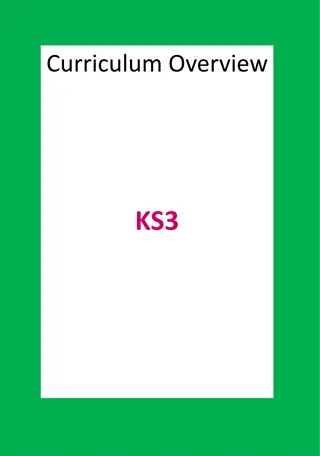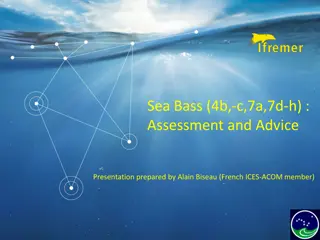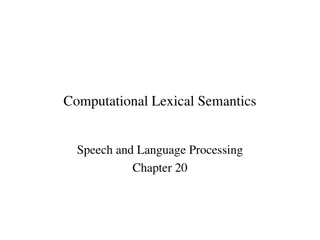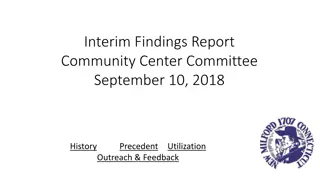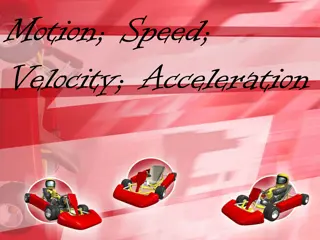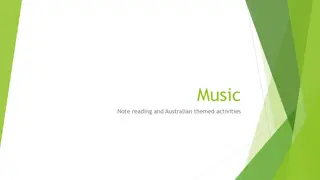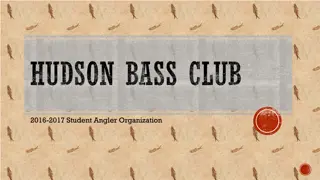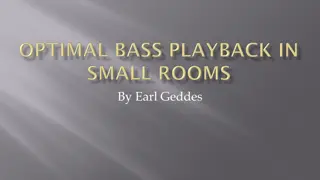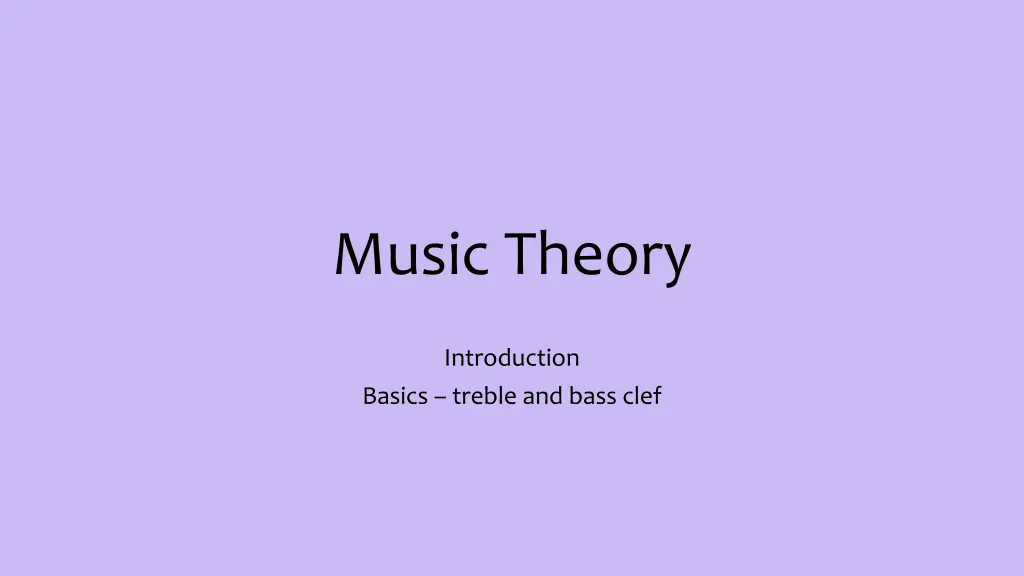
Understanding Music Notation Basics
Dive into the world of music theory with a focus on music notation basics such as treble and bass clef, pitches, staff anatomy, and musical symbols. Learn how to read and interpret sheet music to understand the language of music.
Download Presentation

Please find below an Image/Link to download the presentation.
The content on the website is provided AS IS for your information and personal use only. It may not be sold, licensed, or shared on other websites without obtaining consent from the author. If you encounter any issues during the download, it is possible that the publisher has removed the file from their server.
You are allowed to download the files provided on this website for personal or commercial use, subject to the condition that they are used lawfully. All files are the property of their respective owners.
The content on the website is provided AS IS for your information and personal use only. It may not be sold, licensed, or shared on other websites without obtaining consent from the author.
E N D
Presentation Transcript
Music Theory Introduction Basics treble and bass clef
A note about taking notes-- I will post powerpoints on my website for study and/or review. You should STILL take notes during class. You may print powerpoints to keep in your notebook print on black and white, and not greyscale. I recommend using one piece of lined paper per one piece of manuscript paper for each class. How to know what to write down: If it s underlined with its definition If it s confusing to you. If I tell you it s important to know. Write smart notes paraphrase! If you re not sure, just ask.
Why are we doing this? Music notation is the art of recording music in written form. Music theory is the study of music notation. The goal: if you can read it, you can hear it. If you can hear it, you can reproduce it.
Why are we starting with the easy stuff? We need a common language.
How do we record music in the written form? EVERY musical symbol relates to either pitch or time. Pitch = the highness or lowness of a sound (in physics: think frequency) Time = the when, the for how long, the how many times. Intensity = how strong, how loud, how soft etc. Just remember: Modern music notation is a product of centuries of transformation and it is neither efficient nor intuitive! Toby Rush (tobyrush.com) great infographs!
Todays goal: To identify the relative lowness or highness of a pitch by observing its location on the staff. AKA To identify various pitches.
The anatomy of sheet music Read left to right, like a book. Clef, time signature, key signature = set the stage. Notes : letters :: melody : sentence Double bar line = the end
The anatomy of a musical note Name the various parts of these notes: draw/write this down Notes become pitches when we place them on the staff.
Building blocks Every pitch has its spot on the staff. Staff: 5 lines and 4 spaces on which we write our pitches If a note is: Higher on the staff = higher in pitch. Lower on the staff = lower in pitch.
IMPORTANT: Pitches exist on lines and spaces, alternating when in order, stepwise. Line notes = bead on a string. Space notes = meatball sandwiches. Practice: 1. Draw one filled-in note head on each line and space of your staff, starting at the top, in descending order. 2. 2. Stop when you ve drawn a note head on the bottom line of the staff. 3. Then, compare with the person next to you. Check: how many note heads did you draw?
Example: These pitches do not move in stepwise motion. Practice: 1. Draw these pitches on your staff, leaving space between. Do not draw any stems. 2. Then, draw any and all pitches that were skipped. 3. Check: compare with your neighbor, point out any mistakes.
Now add stems Below the 3rdline: stems drawn up and to the right (d) On or above the 3rdline: stems drawn down and to the left (P) Stems: make sure they are Mama Bear not too long, not too short. Just right. Practice: draw all of these notes.
Now we have to name these pitches that we ve drawn.
The Musical Alphabet Every pitch has a name: A B C D E F G All As sound the same All Bs sound the same Etc. The musical alphabet is cyclical. So, when you reach the end, you start over again at the beginning. Question: what pitch comes after G?
The Musical Alphabet When pitches ascend step by step, they follow the musical alphabet forwards. When pitches descend step by step, they follow the musical alphabet BACKWARDS. Question: which am I playing on the piano? ABCDEFG -OR- GFEDCBA?
Lets start with the treble clef Why? Most common, young children, etc. Treble: higher pitches Also called G Clef for 2 reasons: write this down 1. It kind of looks like a G 2. The swirl of the clef shows us where G exists on the staff The evolution of the treble clef (probably)
Wait: the swirl shows us where G is? Yes! The swirl outlines the spot on the clef where one can always find G. Miss Gothers, it starts on E! That s weird! Yes. Relax.
Practice time On your manuscript paper, practice drawing 6 treble clefs.
Okay, I can find G. What about A through F? Remember, as pitches get higher by step, we follow the musical alphabet forwards As pitches get lower by step, we follow the musical alphabet backwards. So, if you know where G is, you can use the alphabet to find any other note.
Sometimes that takes too long. Finding G and counting up or down is inefficient. Until the staff is second-nature, there are two other tricks: Line vs. Space.
Treble Clef Lines How many lines are there on the staff? The line trick has ___ words because there are ___ lines on the staff. Empty Garbage Before Flips Dad Note use the trick from the bottom to the top (think: Meghan Trainor)
Treble Clef Spaces How many spaces are there on the staff? The space trick has ___ letters because the staff has ___ spaces. Space is for FACE A F C E Notice use the trick from the bottom to the top (think: Meghan Trainor)
Practice: Around the World Level 1: Treble Clef
We also have a bass clef Why? 88 keys, low voices Bass: lower pitches Also called F Clef for 2 reasons: 1. It kind of looks like a F 2. The dots of the clef shows us where F exists on the staff The evolution of the bass clef (probably)
Wait: the dots shows us where F is? Yes! The big dot is drawn on the spot of the staff where one can always find F. The other two dots surround F Miss Gothers, it starts on G! That s weirder! Yes. Relax.
Practice time On your manuscript paper, practice drawing 6 bass clefs.
Okay, I can find F. What about G through E? Remember, as pitches get higher by step, we follow the musical alphabet forwards As pitches get lower by step, we follow the musical alphabet backwards. So, if you know where F is, you can use the alphabet to find any other note.
Sometimes that takes too long. Finding F and counting up or down is inefficient. Until the staff is second-nature, there are two other tricks: Line vs. Space.
Bass Clef Lines How many lines are there on the staff? Good Boys Do Fine Always Notice use the trick from the bottom to the top (think: Meghan Trainor)
Treble Clef Spaces How many spaces are there on the staff? All Cows Eat Grass Notice use the trick from the bottom to the top (think: Meghan Trainor)
Why do we need clefs? Without seeing a clef, these pitches could be: Treble: G and C Bass: B and E Notes do not have meaning without clefs.
Practice: Around the World Level 2: Bass Clef Level 3: Either Clef

